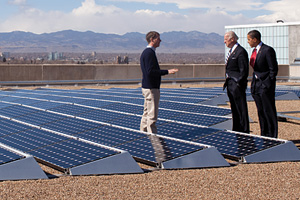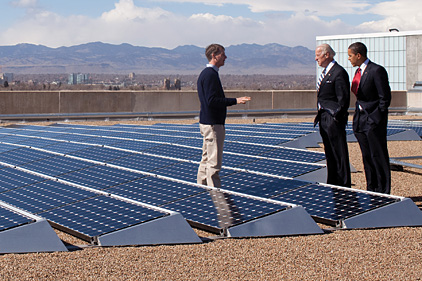
|
| More than $150 million in leftover tax credits for investments in manufacturing facilities for clean energy technologies, like solar technology, are now available in the second phase of the 48C Advanced Manufacturing Tax Credit. |
The Departments of Energy and the Treasury recently announced they will be reallocating more than $150 million in tax credits for investments in manufacturing facilities for clean-energy technologies in Phase II of the 48C Advanced Manufacturing Tax Credit.
The $150 million is leftover from 48C Phase I, which originally provided $2.3 billion in competitive tax credits for clean-energy manufacturers as part of the American Recovery and Reinvestment Act of 2009 (ARRA).
48C Returns
The first phase of the 48C tax credit provided 183 manufacturers with a competitively awarded 30 percent investment tax credit with the goal of supporting investment in domestic, clean energy, and energy-efficiency manufacturing facilities. In the four years since the tax credit was implemented, the U.S. has more than doubled its clean, renewable-energy generation from wind, solar, and geothermal sources, helping the U.S. to participate more competitively in the global clean-energy race, according to the Department of Energy (DOE).
“These new investments will continue that momentum, supporting the president’s commitment to American-made energy, increasing energy security, and creating jobs,” said outgoing Energy Secretary Steven Chu.
According to the DOE, projects will be assessed based on the following criteria: commercial viability, domestic job creation, technological innovation, speed to project completion, and potential for reducing air pollution and greenhouse gas emissions. The DOE will also consider additional factors, including diversity of geography, technology, project size, and regional economic development.
Important Incentives
Dan Ellis, president of ClimateMaster Inc., said tax incentives like 48C are invaluable to the clean-energy industry – and specifically the geothermal heat pump industry, which first began utilizing federal tax incentives for alternative energy technologies in the late 1970s.
“I am not sure our industry would even exist without the boost provided by those original incentives,” Ellis said. “The future of our industry post-incentives will be built on the foundation created by a large base of successful installations, hopefully assisted by a soft landing in terms of a phase-out policy.”
Ellis stressed that manufacturers are not the only ones who have benefitted from the tax incentives over the years. “The increase in sales and awareness has spurred industry investment across the board. Manufacturers have accelerated product development and have expanded and improved their production capacity. Geothermal loop contractors have purchased drilling and trenching equipment. Contractors and distributors have heavily invested in training.”
Even if the 48C tax credit isn’t enough of an incentive to spur significant investments for manufacturers, “The 30 percent tax credit certainly provides an incentive to be more aggressive in capital investment,” Ellis said.
A Good Thing
Doug Dougherty, president and CEO of the Geothermal Exchange Organization (GEO), said he is pleased to see the tax incentives return. “I think it’s good for the industry,” he said. “Any time we can stimulate research and development and improve our industry, that’s important.”
Dougherty agreed with Ellis that 48C, along with other local, state, and federal incentives have clearly had a positive impact on the industry.
“If you look at some of the improvements that have been made in the geothermal heat pump industry in the past few years, that’s a direct result of the money that companies are spending,” Dougherty said. “If the government will help a company invest, it’s a good thing.”
Jigar Shah, founder of Sun Edison LLC and current partner at Inerjys, a clean-energy investment firm, said the tax incentives have played an important role in helping to make the U.S. a global competitor in the clean-energy world. Keeping clean-energy manufacturing in the U.S. also keeps product and energy costs down for Americans, he said, noting that “it’s cheaper to manufacture here than to manufacture elsewhere and truck it in.”
Shah said the U.S. is now keeping pace with China in the race to be the leader in solar energy, and that the clean-energy tax incentives have helped keep clean-energy jobs in the U.S. “We’re winning, and we’re putting huge amounts of capital in the ground,” he said.
The 48C tax credit is especially helpful for businesses that are not as keen to invest due to the stormy economic climate. “Right now, we’re in a mood where people aren’t aggressively investing,” Shah said. “This is a very basic program, where if you invest a dollar, you get a 30 cent tax credit back. This helps to get manufacturers over their malaise.”
To be considered for an allocation of credits in the 48C Phase II program, taxpayers must submit concept papers to the DOE by April 9 and applications to the DOE and the IRS by July 23. For more information about the 48C Phase II Program, visit www.energy.gov.
SIDEBAR: What Qualifies for 48C?
According to the IRS, the following items qualify for the 48C Advanced Manufacturing Tax Credit:
• Solar, wind, geothermal, or other renewable-energy equipment;
• Electric grids and storage for renewables;
• Fuel cells and microturbines;
• Energy storage systems for electric or hybrid vehicles;
• Carbon dioxide capture and sequestration equipment;
• Equipment for refining or blending renewable fuels;
• Equipment for energy conservation, including lighting and smart grid technologies; and
• Other advanced energy property designed to reduce greenhouse gas emissions may also be eligible as determined by the secretary of the Treasury.
The timeline for applying for the credit is as follows:
• The application period for certification begins on Feb. 7, and ends on July 23.
• A concept paper for DOE consideration must be submitted by April 9. If after review of the concept paper DOE invites an applicant to submit an application for DOE recommendation, the application must be submitted by July 23. All timely submitted applications will be evaluated and ranked on their merit regardless of when in the application period they are submitted.
• If an application for DOE recommendation is received on time and otherwise meets the preliminary compliance review criteria, DOE will determine the merit of the project. For projects determined to be meritorious, DOE will provide recommendation to the IRS no later than Oct. 11.
• The timeliness for any concept paper and application will be determined by the submittal date and time information provided by DOE’s Exchange website. Instructions for submitting concept papers, applications, and supporting documents through Exchange are provided in Appendix B, Section IV of Notice 2013-12.
• The IRS will accept or reject the taxpayer’s application for 48C certification by Nov. 15, and will notify the taxpayer, by letter, of its decision. If the application is accepted, the date of this letter will be treated as the acceptance date.
Publication date: 3/25/2013



Report Abusive Comment